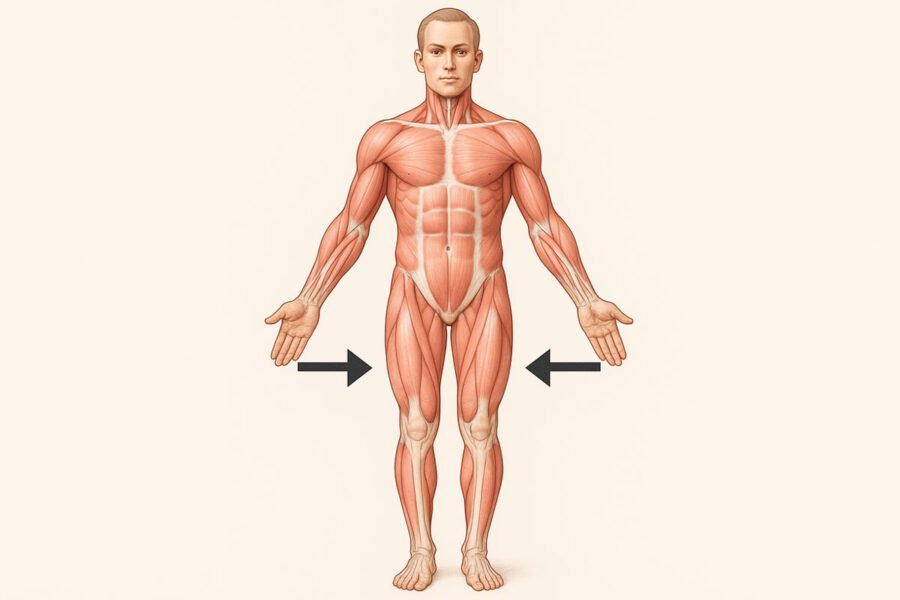Skip to the good bit
ToggleWhat is Adduction? A Clear Definition
The Anatomical Perspective
Ever wondered how your body brings your limbs back to your core? That movement has a name: adduction. In the world of anatomy, adduction is the motion of a body part moving toward the body’s central line. Think of an invisible line that divides your body into left and right halves—that’s your sagittal plane, and adduction is all about getting closer to it.
Picture this: you’re standing with your arms stretched wide. When you bring them back down to your sides, that’s adduction in action. It’s a fundamental piece of body movement that we use constantly, whether we’re walking down the street or reaching for a cup of coffee.
Adduction vs. Abduction: A Simple Analogy
It’s easy to get adduction mixed up with its opposite, abduction. Abduction is when you move a limb away from your body’s midline. So, how can you keep them straight? Here’s a handy trick: think of adduction as “adding” a limb back to your body.
On the flip side, you can think of abduction as “taking away.” Getting this distinction right is the first step to understanding the elegant partnership between different muscle groups that allows for our incredible range of motion and joint mobility.
The Muscles of Adduction
Key Adductor Muscle Groups
So, what’s doing all the work? A few key muscle groups are the stars of the adduction show. When it comes to your hips, the main players are a set of muscles on your inner thigh—the adductor magnus, longus, and brevis. You might know them better as your groin muscles.
For your shoulders, the heavy lifters are your pectoralis major (your main chest muscle) and the latissimus dorsi, a large, fan-shaped muscle on your back. These powerhouses work together to bring your arm in toward your chest.
How These Muscles Function in Daily Life
Believe it or not, your adductor muscles are working for you all day long. They help keep your pelvis stable when you walk, preventing you from waddling. Every time you cross your legs while sitting, you have your hip adductors to thank.
Simple actions like pulling a door closed or hugging a friend rely on shoulder adduction. This muscle function is woven into the fabric of our daily lives, providing both strength and control.
The Importance of Adduction in Physical Fitness
Adduction Exercises for Strength and Stability
If you’re looking to build a truly strong and stable body, you can’t ignore your adductors. Exercise science has shown that targeted workouts are essential. Moves like side lunges, cable hip adduction, and the classic clamshell are fantastic for honing in on these crucial muscles.
A smart fitness plan isn’t just about the muscles you can see in the mirror. It includes exercises for both adduction and abduction to create a balanced, resilient physique.
Preventing Injury Through Balanced Muscle Training
Why is that balance so important? When your adductor and abductor muscles are out of sync, you’re setting yourself up for trouble. Weak adductors can lead to poor knee stability and a higher risk of those dreaded groin strains, a common complaint for athletes in sports with a lot of side-to-side action.
By building and maintaining harmony between these opposing muscle groups, you’re not just improving your performance; you’re investing in long-term joint health and effective injury prevention.
Adduction in a Clinical and Rehabilitation Context
Common Adduction-Related Issues
In a medical setting, problems with adduction can be a red flag for other health issues. For instance, children with cerebral palsy sometimes develop adduction contractures, which cause their legs to pull together and cross, making walking a challenge.
For athletes, especially in sports like soccer or hockey, adductor muscle strains are a frequent and frustrating injury. Proper physical therapy and rehabilitation are key to a successful recovery.
The Role of Adduction in Physical Therapy
Speaking of rehabilitation, adduction exercises are a cornerstone of many physical therapy programs. After an injury or surgery, controlled adduction movements are prescribed to carefully rebuild strength, increase range of motion, and retrain muscle function.
Therapists use a progressive approach, gradually increasing the challenge to help people get back on their feet, restore their functional movement, and return to the activities they love.
Conclusion: The Integral Role of Adduction
So, adduction is far more than just a word in an anatomy textbook. It’s a core component of our physical existence, governing our stability, power, and mobility.
From the simple rhythm of our daily walk to the explosive power of an elite athlete, the adductor muscles are the unsung heroes. Understanding their role and giving them the attention they deserve is a critical step toward a life of healthy, functional movement.







